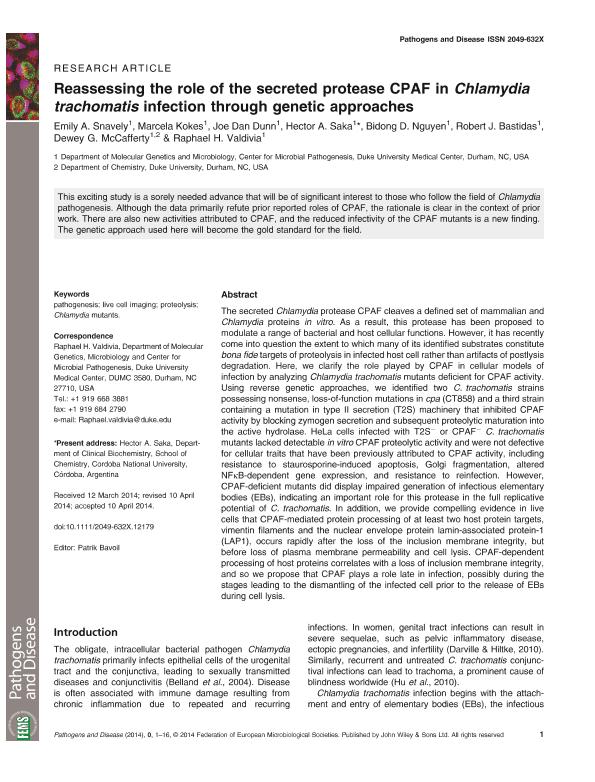Artículo
Reassessing the role of the secreted protease CPAF in Chlamydia trachomatis infection through genetic approaches
Snavely, Emily; Kokes, Marcela; Dunn, Joe Dan; Saka, Hector Alex ; Nguyen, Bidong D.; Bastidas, Robert J.; McCafferty, Dewey G.; Valdivia, Raphael H.
; Nguyen, Bidong D.; Bastidas, Robert J.; McCafferty, Dewey G.; Valdivia, Raphael H.
 ; Nguyen, Bidong D.; Bastidas, Robert J.; McCafferty, Dewey G.; Valdivia, Raphael H.
; Nguyen, Bidong D.; Bastidas, Robert J.; McCafferty, Dewey G.; Valdivia, Raphael H.
Fecha de publicación:
05/2014
Editorial:
John Wiley & Sons
Revista:
Pathogens and disease
ISSN:
2049-632X
Idioma:
Inglés
Tipo de recurso:
Artículo publicado
Clasificación temática:
Resumen
The secreted Chlamydia protease CPAF cleaves a defined set of mammalian and Chlamydia proteins in vitro. As a result, this protease has been proposed to modulate a range of bacterial and host cellular functions. However, it has recently come into question the extent to which many of its identified substrates constitute bona fide targets of proteolysis in infected host cell rather than artifacts of postlysis degradation. Here, we clarify the role played by CPAF in cellular models of infection by analyzing Chlamydia trachomatis mutants deficient for CPAF activity. Using reverse genetic approaches, we identified two C. trachomatis strains possessing nonsense, loss of function mutations in cpa (CT858) and a third strain containing a mutation in type II secretion (T2S) machinery that inhibited CPAF activity by blocking zymogen secretion and subsequent proteolytic maturation into the active hydrolase. HeLa cells infected with T2S− or CPAF−C. trachomatis mutants lacked detectable in vitro CPAF proteolytic activity and were not defective for cellular traits that have been previously attributed to CPAF activity, including resistance to staurosporine induced apoptosis, Golgi fragmentation, altered NFκB dependent gene expression, and resistance to reinfection. However, CPAF deficient mutants did display impaired generation of infectious elementary bodies (EBs), indicating an important role for this protease in the full replicative potential of C. trachomatis. In addition, we provide compelling evidence in live cells that CPAF mediated protein processing of at least two host protein targets, vimentin filaments and the nuclear envelope protein lamin associated protein 1 (LAP1), occurs rapidly after the loss of the inclusion membrane integrity, but before loss of plasma membrane permeability and cell lysis. CPAF dependent processing of host proteins correlates with a loss of inclusion membrane integrity, and so we propose that CPAF plays a role late in infection, possibly during the stages leading to the dismantling of the infected cell prior to the release of EBs during cell lysis.
Palabras clave:
Pathogenesis
,
Live Cell Imaging
,
Proteolysis
,
Chlamydia Mutants
Archivos asociados
Licencia
Identificadores
Colecciones
Articulos(CCT - CORDOBA)
Articulos de CTRO.CIENTIFICO TECNOL.CONICET - CORDOBA
Articulos de CTRO.CIENTIFICO TECNOL.CONICET - CORDOBA
Citación
Snavely, Emily; Kokes, Marcela; Dunn, Joe Dan; Saka, Hector Alex; Nguyen, Bidong D.; et al.; Reassessing the role of the secreted protease CPAF in Chlamydia trachomatis infection through genetic approaches; John Wiley & Sons; Pathogens and disease; 71; 3; 5-2014; 336-351
Compartir
Altmétricas



